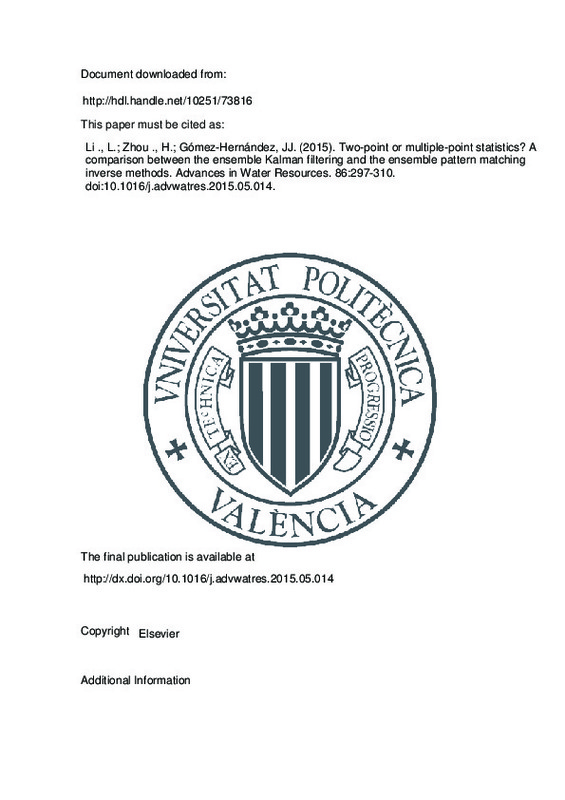JavaScript is disabled for your browser. Some features of this site may not work without it.
Buscar en RiuNet
Listar
Mi cuenta
Estadísticas
Ayuda RiuNet
Admin. UPV
Two-point or multiple-point statistics? A comparison between the ensemble Kalman filtering and the ensemble pattern matching inverse methods
Mostrar el registro sencillo del ítem
Ficheros en el ítem
| dc.contributor.author | Li, Liangping
|
es_ES |
| dc.contributor.author | Srinivasan, Sanjay
|
es_ES |
| dc.contributor.author | Zhou, Haiyan
|
es_ES |
| dc.contributor.author | Gomez-Hernandez, J. Jaime
|
es_ES |
| dc.date.accessioned | 2016-11-10T15:51:22Z | |
| dc.date.available | 2016-11-10T15:51:22Z | |
| dc.date.issued | 2015-12 | |
| dc.identifier.issn | 0309-1708 | |
| dc.identifier.uri | http://hdl.handle.net/10251/73816 | |
| dc.description.abstract | The Ensemble Kalman Filter (EnKF) has been commonly used to assimilate real time dynamic data into geologic models over the past decade. Despite its various advantages such as computational efficiency and its capability to handle multiple sources of uncertainty, the EnKF may not be used to reliably update models that are characterized by curvilinear geometries such as fluvial deposits where the permeable channels play a crucial role in the prediction of solute transport. It is well-known that the EnKF performs optimally for updating multi-Gaussian distributed fields, basically because it uses two-point statistics (i.e., covariances) to represent the relationship between the model parameters and between the model parameters and the observed response, and this is the only statistic necessary to fully characterize a multiGaussian distribution. The Ensemble PATtern matching (EnPAT) is an alternative ensemble based method that shows significant potential to condition complex geology such as channelized aquifers to dynamic data. The EnPAT is an evolution of the EnKF, replacing, in the analysis step, two-point statistics with multiple-point statistics. The advantages of EnPAT reside in its capability to honor the complex spatial connectivity of geologic structures as well as the measured static and dynamic data. In this work, the performance of the classical EnKF and the EnPAT are compared for modeling a synthetic channelized aquifer. The results reveal that the EnPAT yields a better prediction of transport characteristics than the EnKF because it characterizes the conductivity heterogeneity better. Issues such as uncertainty of multiple variables and the effect of measurement errors on EnPAT results will be discussed. © 2015 Elsevier Ltd. All rights reserved. | es_ES |
| dc.description.sponsorship | The first three authors gratefully acknowledge the financial support by the U.S. Department of Energy through project DE-FE0004962. The fourth author acknowledges the financial support by the Spanish Ministry of Economy and Competitiveness through project CGL2011-23295. We thank the guest editor Prof. Dr. Harrie-Jan Hendricks Franssen, as well as the reviewer Prof. Alberto Guadagnini and two anonymous reviewers for their comments, which substantially improved the manuscript. | en_EN |
| dc.language | Inglés | es_ES |
| dc.publisher | Elsevier | es_ES |
| dc.relation.ispartof | Advances in Water Resources | es_ES |
| dc.rights | Reserva de todos los derechos | es_ES |
| dc.subject | Multiple-point statistics | es_ES |
| dc.subject | Rejection sampling | es_ES |
| dc.subject | Conditional simulation | es_ES |
| dc.subject | Ensemble Kalman filter | es_ES |
| dc.subject | Inverse method | es_ES |
| dc.subject.classification | INGENIERIA HIDRAULICA | es_ES |
| dc.title | Two-point or multiple-point statistics? A comparison between the ensemble Kalman filtering and the ensemble pattern matching inverse methods | es_ES |
| dc.type | Artículo | es_ES |
| dc.identifier.doi | 10.1016/j.advwatres.2015.05.014 | |
| dc.relation.projectID | info:eu-repo/grantAgreement/MICINN//CGL2011-23295/ES/MODELACION ESTOCASTICA INVERSA FUERA DE LO NORMAL/ | es_ES |
| dc.relation.projectID | info:eu-repo/grantAgreement/DOE//DE-FE0004962/ | es_ES |
| dc.rights.accessRights | Abierto | es_ES |
| dc.contributor.affiliation | Universitat Politècnica de València. Escuela Técnica Superior de Ingenieros de Caminos, Canales y Puertos - Escola Tècnica Superior d'Enginyers de Camins, Canals i Ports | es_ES |
| dc.contributor.affiliation | Universitat Politècnica de València. Departamento de Ingeniería Hidráulica y Medio Ambiente - Departament d'Enginyeria Hidràulica i Medi Ambient | es_ES |
| dc.description.bibliographicCitation | Li, L.; Srinivasan, S.; Zhou, H.; Gomez-Hernandez, JJ. (2015). Two-point or multiple-point statistics? A comparison between the ensemble Kalman filtering and the ensemble pattern matching inverse methods. Advances in Water Resources. 86:297-310. https://doi.org/10.1016/j.advwatres.2015.05.014 | es_ES |
| dc.description.accrualMethod | S | es_ES |
| dc.relation.publisherversion | http://dx.doi.org/10.1016/j.advwatres.2015.05.014 | es_ES |
| dc.description.upvformatpinicio | 297 | es_ES |
| dc.description.upvformatpfin | 310 | es_ES |
| dc.type.version | info:eu-repo/semantics/publishedVersion | es_ES |
| dc.description.volume | 86 | es_ES |
| dc.relation.senia | 300521 | es_ES |
| dc.contributor.funder | Ministerio de Ciencia e Innovación | es_ES |
| dc.contributor.funder | U.S. Department of Energy | es_ES |







![[Cerrado]](/themes/UPV/images/candado.png)

